KPMG Leadership and Crisis Management: TMA 2 Report Analysis
VerifiedAdded on 2022/09/14
|14
|2911
|16
Report
AI Summary
This report analyzes crisis management and leadership styles, using KPMG as a case study. It begins by outlining steps for starting an interior design business, covering services, style, branding, and operational aspects. The report then defines crisis management, discussing crisis situations and the importance of recognizing challenges and implementing solutions. The core of the report examines employee motivation at KPMG, focusing on the impact of penalties and comparing leadership styles across KPMG, Ernst & Young, and PriceWaterHouseCoopers, highlighting task management, middle-of-the-road, and team management approaches. The report concludes by differentiating between extrinsic and intrinsic motivators, suggesting ways to improve employee engagement within KPMG through acknowledging good behavior and offering opportunities for skill development. The analysis demonstrates the impact of leadership styles on employee morale and organizational outcomes.

Running head: PRINCIPLES AND PRACTICE OF MANAGEMENT
TMA 2: Principles and Practice of Management
Name of the University:
Name of the Student:
Authors Note:
TMA 2: Principles and Practice of Management
Name of the University:
Name of the Student:
Authors Note:
Paraphrase This Document
Need a fresh take? Get an instant paraphrase of this document with our AI Paraphraser

1PRINCIPLES AND PRACTICE OF MANAGEMENT
Table of Contents
Introduction......................................................................................................................................2
Question 1........................................................................................................................................2
Part (a).........................................................................................................................................2
Part (b).........................................................................................................................................6
Question 2........................................................................................................................................7
Part (a).........................................................................................................................................7
Part (b).........................................................................................................................................8
Part (c).........................................................................................................................................9
Conclusion.....................................................................................................................................10
References......................................................................................................................................11
Table of Contents
Introduction......................................................................................................................................2
Question 1........................................................................................................................................2
Part (a).........................................................................................................................................2
Part (b).........................................................................................................................................6
Question 2........................................................................................................................................7
Part (a).........................................................................................................................................7
Part (b).........................................................................................................................................8
Part (c).........................................................................................................................................9
Conclusion.....................................................................................................................................10
References......................................................................................................................................11

2PRINCIPLES AND PRACTICE OF MANAGEMENT
Introduction
The objective of the report was to analyze the concept of crisis management and analyze
the case study of KMPG in recognizing concerns that motivate the employees of the company.
Moreover, it will also analyze the leadership styles followed in KPMG, Ernst & Young and
PriceWaterHouseCoopers based on the managerial grid.
Question 1
Part (a)
Individuals that have the creativity, skills, and knowledge required to design an interior
space is called as an interior designer (Ching& Binggeli, 2017).Starting up any firm in this area
requires a lot of steps. Amanda can follow the following steps to start her own business.
Determining the services, she will offer.
The first thing she need to plan are the types of services she’ll offer. As an interior designer,
she will have to make sure that she is not taking projects more than she can handle. If she only
wants to design bed room and drawing, for example, she needs to make it clear from the get-go.
If she is going the e-design route or going online with her business, she needs to make a list of
specific deliverables.
3D renderings.
Shopping lists.
Paint palettes.
Mood boards.
Detailed notes (Berg& Kreiner, 2017).
Introduction
The objective of the report was to analyze the concept of crisis management and analyze
the case study of KMPG in recognizing concerns that motivate the employees of the company.
Moreover, it will also analyze the leadership styles followed in KPMG, Ernst & Young and
PriceWaterHouseCoopers based on the managerial grid.
Question 1
Part (a)
Individuals that have the creativity, skills, and knowledge required to design an interior
space is called as an interior designer (Ching& Binggeli, 2017).Starting up any firm in this area
requires a lot of steps. Amanda can follow the following steps to start her own business.
Determining the services, she will offer.
The first thing she need to plan are the types of services she’ll offer. As an interior designer,
she will have to make sure that she is not taking projects more than she can handle. If she only
wants to design bed room and drawing, for example, she needs to make it clear from the get-go.
If she is going the e-design route or going online with her business, she needs to make a list of
specific deliverables.
3D renderings.
Shopping lists.
Paint palettes.
Mood boards.
Detailed notes (Berg& Kreiner, 2017).
⊘ This is a preview!⊘
Do you want full access?
Subscribe today to unlock all pages.

Trusted by 1+ million students worldwide
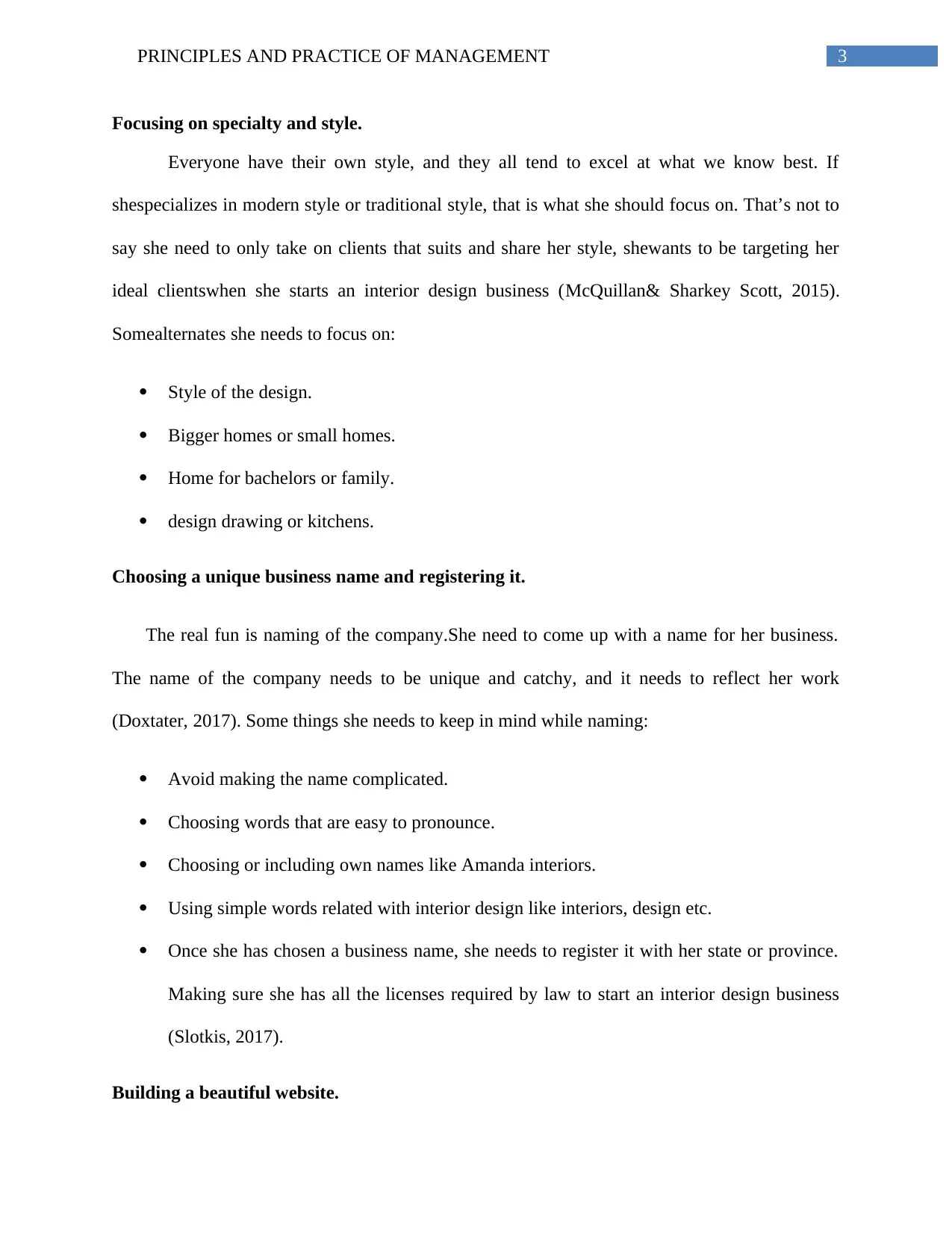
3PRINCIPLES AND PRACTICE OF MANAGEMENT
Focusing on specialty and style.
Everyone have their own style, and they all tend to excel at what we know best. If
shespecializes in modern style or traditional style, that is what she should focus on. That’s not to
say she need to only take on clients that suits and share her style, shewants to be targeting her
ideal clientswhen she starts an interior design business (McQuillan& Sharkey Scott, 2015).
Somealternates she needs to focus on:
Style of the design.
Bigger homes or small homes.
Home for bachelors or family.
design drawing or kitchens.
Choosing a unique business name and registering it.
The real fun is naming of the company.She need to come up with a name for her business.
The name of the company needs to be unique and catchy, and it needs to reflect her work
(Doxtater, 2017). Some things she needs to keep in mind while naming:
Avoid making the name complicated.
Choosing words that are easy to pronounce.
Choosing or including own names like Amanda interiors.
Using simple words related with interior design like interiors, design etc.
Once she has chosen a business name, she needs to register it with her state or province.
Making sure she has all the licenses required by law to start an interior design business
(Slotkis, 2017).
Building a beautiful website.
Focusing on specialty and style.
Everyone have their own style, and they all tend to excel at what we know best. If
shespecializes in modern style or traditional style, that is what she should focus on. That’s not to
say she need to only take on clients that suits and share her style, shewants to be targeting her
ideal clientswhen she starts an interior design business (McQuillan& Sharkey Scott, 2015).
Somealternates she needs to focus on:
Style of the design.
Bigger homes or small homes.
Home for bachelors or family.
design drawing or kitchens.
Choosing a unique business name and registering it.
The real fun is naming of the company.She need to come up with a name for her business.
The name of the company needs to be unique and catchy, and it needs to reflect her work
(Doxtater, 2017). Some things she needs to keep in mind while naming:
Avoid making the name complicated.
Choosing words that are easy to pronounce.
Choosing or including own names like Amanda interiors.
Using simple words related with interior design like interiors, design etc.
Once she has chosen a business name, she needs to register it with her state or province.
Making sure she has all the licenses required by law to start an interior design business
(Slotkis, 2017).
Building a beautiful website.
Paraphrase This Document
Need a fresh take? Get an instant paraphrase of this document with our AI Paraphraser
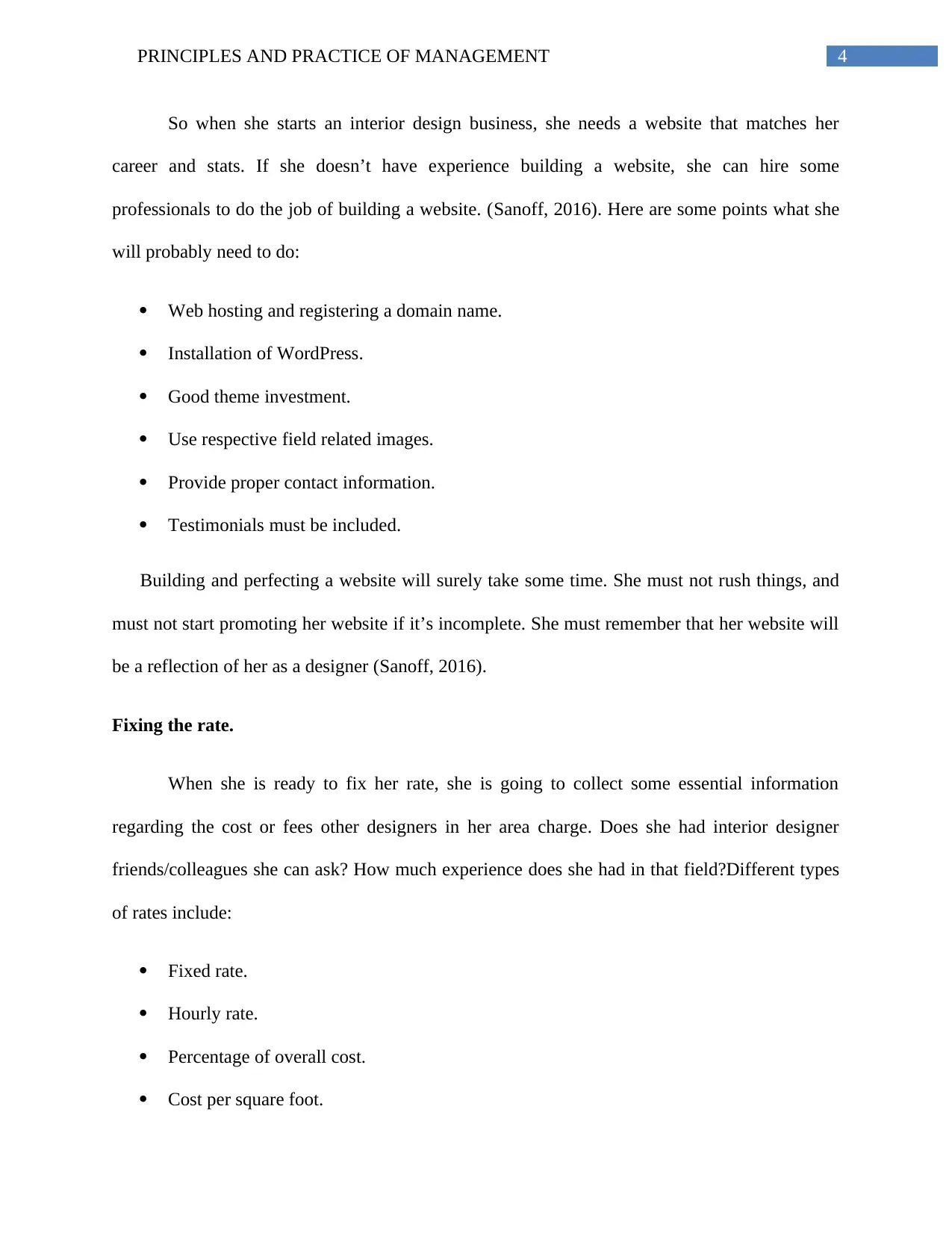
4PRINCIPLES AND PRACTICE OF MANAGEMENT
So when she starts an interior design business, she needs a website that matches her
career and stats. If she doesn’t have experience building a website, she can hire some
professionals to do the job of building a website. (Sanoff, 2016). Here are some points what she
will probably need to do:
Web hosting and registering a domain name.
Installation of WordPress.
Good theme investment.
Use respective field related images.
Provide proper contact information.
Testimonials must be included.
Building and perfecting a website will surely take some time. She must not rush things, and
must not start promoting her website if it’s incomplete. She must remember that her website will
be a reflection of her as a designer (Sanoff, 2016).
Fixing the rate.
When she is ready to fix her rate, she is going to collect some essential information
regarding the cost or fees other designers in her area charge. Does she had interior designer
friends/colleagues she can ask? How much experience does she had in that field?Different types
of rates include:
Fixed rate.
Hourly rate.
Percentage of overall cost.
Cost per square foot.
So when she starts an interior design business, she needs a website that matches her
career and stats. If she doesn’t have experience building a website, she can hire some
professionals to do the job of building a website. (Sanoff, 2016). Here are some points what she
will probably need to do:
Web hosting and registering a domain name.
Installation of WordPress.
Good theme investment.
Use respective field related images.
Provide proper contact information.
Testimonials must be included.
Building and perfecting a website will surely take some time. She must not rush things, and
must not start promoting her website if it’s incomplete. She must remember that her website will
be a reflection of her as a designer (Sanoff, 2016).
Fixing the rate.
When she is ready to fix her rate, she is going to collect some essential information
regarding the cost or fees other designers in her area charge. Does she had interior designer
friends/colleagues she can ask? How much experience does she had in that field?Different types
of rates include:
Fixed rate.
Hourly rate.
Percentage of overall cost.
Cost per square foot.
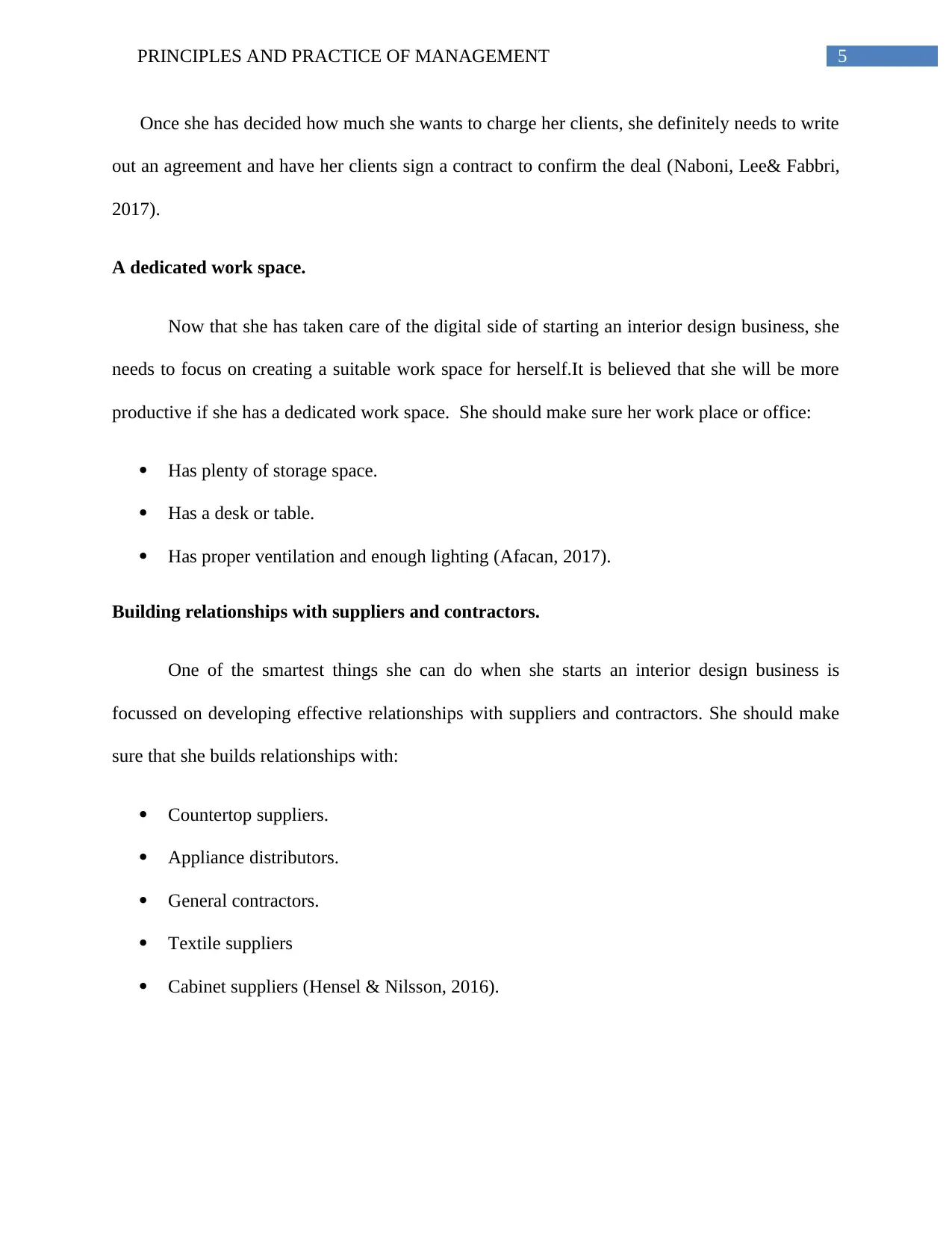
5PRINCIPLES AND PRACTICE OF MANAGEMENT
Once she has decided how much she wants to charge her clients, she definitely needs to write
out an agreement and have her clients sign a contract to confirm the deal (Naboni, Lee& Fabbri,
2017).
A dedicated work space.
Now that she has taken care of the digital side of starting an interior design business, she
needs to focus on creating a suitable work space for herself.It is believed that she will be more
productive if she has a dedicated work space. She should make sure her work place or office:
Has plenty of storage space.
Has a desk or table.
Has proper ventilation and enough lighting (Afacan, 2017).
Building relationships with suppliers and contractors.
One of the smartest things she can do when she starts an interior design business is
focussed on developing effective relationships with suppliers and contractors. She should make
sure that she builds relationships with:
Countertop suppliers.
Appliance distributors.
General contractors.
Textile suppliers
Cabinet suppliers (Hensel & Nilsson, 2016).
Once she has decided how much she wants to charge her clients, she definitely needs to write
out an agreement and have her clients sign a contract to confirm the deal (Naboni, Lee& Fabbri,
2017).
A dedicated work space.
Now that she has taken care of the digital side of starting an interior design business, she
needs to focus on creating a suitable work space for herself.It is believed that she will be more
productive if she has a dedicated work space. She should make sure her work place or office:
Has plenty of storage space.
Has a desk or table.
Has proper ventilation and enough lighting (Afacan, 2017).
Building relationships with suppliers and contractors.
One of the smartest things she can do when she starts an interior design business is
focussed on developing effective relationships with suppliers and contractors. She should make
sure that she builds relationships with:
Countertop suppliers.
Appliance distributors.
General contractors.
Textile suppliers
Cabinet suppliers (Hensel & Nilsson, 2016).
⊘ This is a preview!⊘
Do you want full access?
Subscribe today to unlock all pages.

Trusted by 1+ million students worldwide
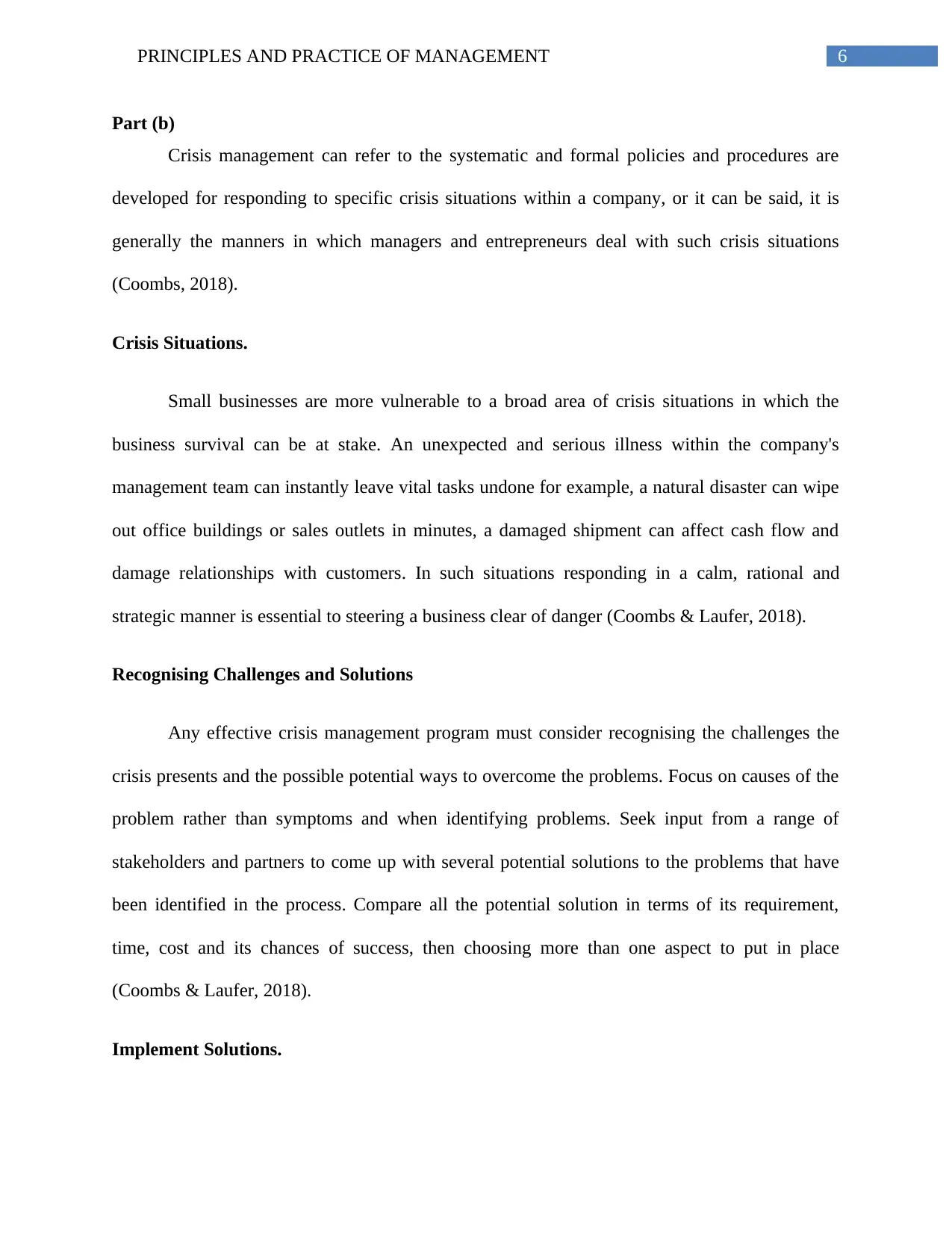
6PRINCIPLES AND PRACTICE OF MANAGEMENT
Part (b)
Crisis management can refer to the systematic and formal policies and procedures are
developed for responding to specific crisis situations within a company, or it can be said, it is
generally the manners in which managers and entrepreneurs deal with such crisis situations
(Coombs, 2018).
Crisis Situations.
Small businesses are more vulnerable to a broad area of crisis situations in which the
business survival can be at stake. An unexpected and serious illness within the company's
management team can instantly leave vital tasks undone for example, a natural disaster can wipe
out office buildings or sales outlets in minutes, a damaged shipment can affect cash flow and
damage relationships with customers. In such situations responding in a calm, rational and
strategic manner is essential to steering a business clear of danger (Coombs & Laufer, 2018).
Recognising Challenges and Solutions
Any effective crisis management program must consider recognising the challenges the
crisis presents and the possible potential ways to overcome the problems. Focus on causes of the
problem rather than symptoms and when identifying problems. Seek input from a range of
stakeholders and partners to come up with several potential solutions to the problems that have
been identified in the process. Compare all the potential solution in terms of its requirement,
time, cost and its chances of success, then choosing more than one aspect to put in place
(Coombs & Laufer, 2018).
Implement Solutions.
Part (b)
Crisis management can refer to the systematic and formal policies and procedures are
developed for responding to specific crisis situations within a company, or it can be said, it is
generally the manners in which managers and entrepreneurs deal with such crisis situations
(Coombs, 2018).
Crisis Situations.
Small businesses are more vulnerable to a broad area of crisis situations in which the
business survival can be at stake. An unexpected and serious illness within the company's
management team can instantly leave vital tasks undone for example, a natural disaster can wipe
out office buildings or sales outlets in minutes, a damaged shipment can affect cash flow and
damage relationships with customers. In such situations responding in a calm, rational and
strategic manner is essential to steering a business clear of danger (Coombs & Laufer, 2018).
Recognising Challenges and Solutions
Any effective crisis management program must consider recognising the challenges the
crisis presents and the possible potential ways to overcome the problems. Focus on causes of the
problem rather than symptoms and when identifying problems. Seek input from a range of
stakeholders and partners to come up with several potential solutions to the problems that have
been identified in the process. Compare all the potential solution in terms of its requirement,
time, cost and its chances of success, then choosing more than one aspect to put in place
(Coombs & Laufer, 2018).
Implement Solutions.
Paraphrase This Document
Need a fresh take? Get an instant paraphrase of this document with our AI Paraphraser
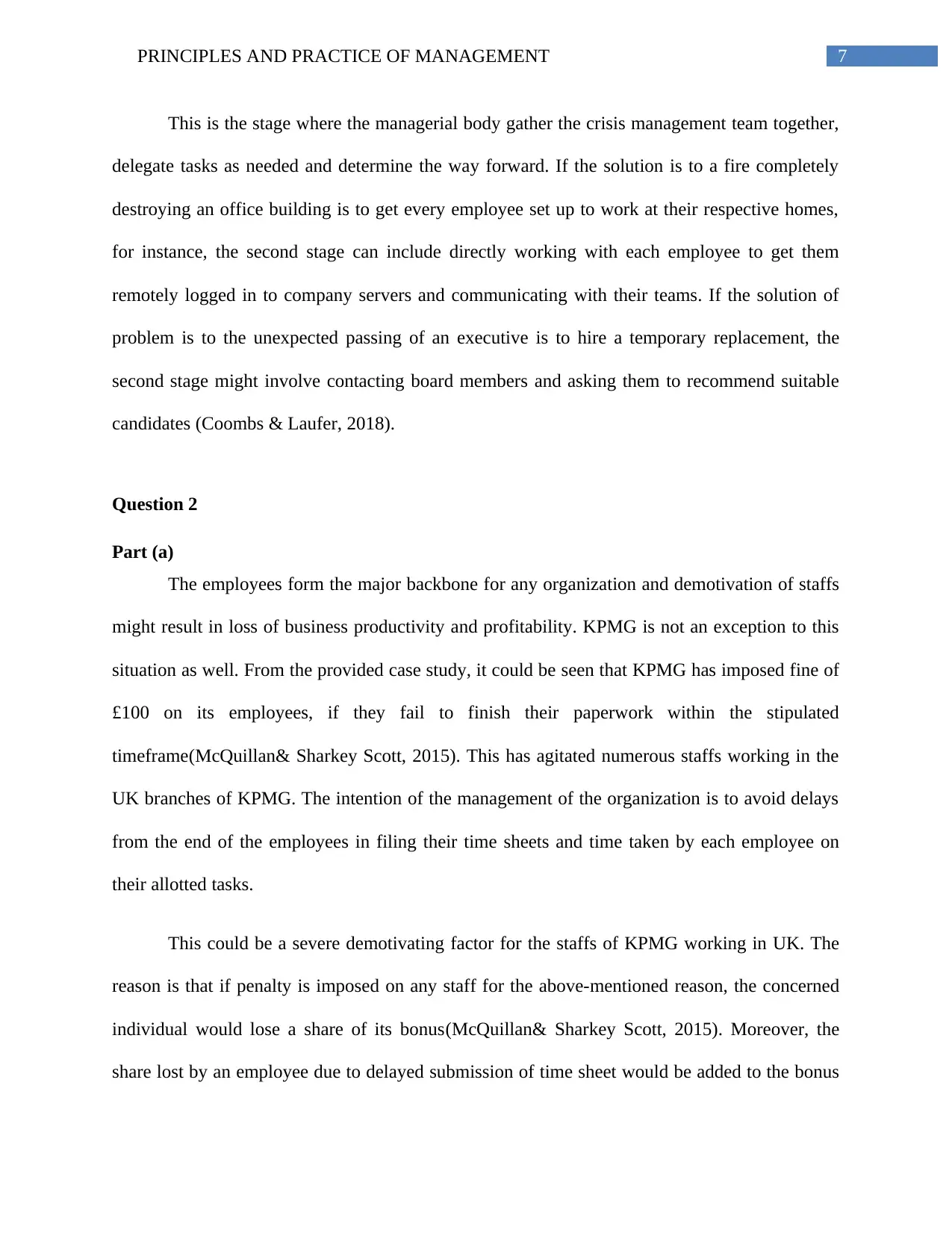
7PRINCIPLES AND PRACTICE OF MANAGEMENT
This is the stage where the managerial body gather the crisis management team together,
delegate tasks as needed and determine the way forward. If the solution is to a fire completely
destroying an office building is to get every employee set up to work at their respective homes,
for instance, the second stage can include directly working with each employee to get them
remotely logged in to company servers and communicating with their teams. If the solution of
problem is to the unexpected passing of an executive is to hire a temporary replacement, the
second stage might involve contacting board members and asking them to recommend suitable
candidates (Coombs & Laufer, 2018).
Question 2
Part (a)
The employees form the major backbone for any organization and demotivation of staffs
might result in loss of business productivity and profitability. KPMG is not an exception to this
situation as well. From the provided case study, it could be seen that KPMG has imposed fine of
£100 on its employees, if they fail to finish their paperwork within the stipulated
timeframe(McQuillan& Sharkey Scott, 2015). This has agitated numerous staffs working in the
UK branches of KPMG. The intention of the management of the organization is to avoid delays
from the end of the employees in filing their time sheets and time taken by each employee on
their allotted tasks.
This could be a severe demotivating factor for the staffs of KPMG working in UK. The
reason is that if penalty is imposed on any staff for the above-mentioned reason, the concerned
individual would lose a share of its bonus(McQuillan& Sharkey Scott, 2015). Moreover, the
share lost by an employee due to delayed submission of time sheet would be added to the bonus
This is the stage where the managerial body gather the crisis management team together,
delegate tasks as needed and determine the way forward. If the solution is to a fire completely
destroying an office building is to get every employee set up to work at their respective homes,
for instance, the second stage can include directly working with each employee to get them
remotely logged in to company servers and communicating with their teams. If the solution of
problem is to the unexpected passing of an executive is to hire a temporary replacement, the
second stage might involve contacting board members and asking them to recommend suitable
candidates (Coombs & Laufer, 2018).
Question 2
Part (a)
The employees form the major backbone for any organization and demotivation of staffs
might result in loss of business productivity and profitability. KPMG is not an exception to this
situation as well. From the provided case study, it could be seen that KPMG has imposed fine of
£100 on its employees, if they fail to finish their paperwork within the stipulated
timeframe(McQuillan& Sharkey Scott, 2015). This has agitated numerous staffs working in the
UK branches of KPMG. The intention of the management of the organization is to avoid delays
from the end of the employees in filing their time sheets and time taken by each employee on
their allotted tasks.
This could be a severe demotivating factor for the staffs of KPMG working in UK. The
reason is that if penalty is imposed on any staff for the above-mentioned reason, the concerned
individual would lose a share of its bonus(McQuillan& Sharkey Scott, 2015). Moreover, the
share lost by an employee due to delayed submission of time sheet would be added to the bonus

8PRINCIPLES AND PRACTICE OF MANAGEMENT
of another employee submitting the task sheets before the provided schedule. However, the work
of an employee could be extended, if that concerned employee is busy in meeting other job
responsibilities or suffering from illness. As a result, some staffs might feel that the management
has exerted unrealistic overload on them, which could make them disillusioned, stressed and loss
of motivation(McQuillan& Sharkey Scott, 2015).
Part (b)
According to the managerial grid, there are five leadership styles that include
impoverished management, task management, middle-of-the-road, country club and team
management. Based on the provided information, it could be stated that KPMG follows the
leadership style of task management, in which the management of the organization emphasizes
more on production rather than on the needs of the staffs(McQuillan& Sharkey Scott, 2015).
This is because the management of KPMG believes that efficiency could arrive only via proper
organization of work systems and through imposing penalties of staffs for delays. In this context,
it is noteworthy to mention that this style of leadership could definitely increase the
organizational output in the short-run. However, owing to the stringent procedures and policies,
the chances of high labor turnover are inevitable(Naboni, Lee& Fabbri, 2017).
From the provided information, it has been observed that Ernst and Young (EY) follows
a culture, in which the employees have full insight of the significance of submitting time sheets
within the designated period. However, the management of EY does not impose any form of
penalties when its staffs fail to meet their deadlines; instead, it reinforces its policies and
procedures. This implies that the management of EY follows middle-of-the-road leadership style,
in which it attempts to maintain a balance between the objectives of the organization and the
needs of the staffs(Naboni, Lee& Fabbri, 2017). Thus, it never pushes the limits of
of another employee submitting the task sheets before the provided schedule. However, the work
of an employee could be extended, if that concerned employee is busy in meeting other job
responsibilities or suffering from illness. As a result, some staffs might feel that the management
has exerted unrealistic overload on them, which could make them disillusioned, stressed and loss
of motivation(McQuillan& Sharkey Scott, 2015).
Part (b)
According to the managerial grid, there are five leadership styles that include
impoverished management, task management, middle-of-the-road, country club and team
management. Based on the provided information, it could be stated that KPMG follows the
leadership style of task management, in which the management of the organization emphasizes
more on production rather than on the needs of the staffs(McQuillan& Sharkey Scott, 2015).
This is because the management of KPMG believes that efficiency could arrive only via proper
organization of work systems and through imposing penalties of staffs for delays. In this context,
it is noteworthy to mention that this style of leadership could definitely increase the
organizational output in the short-run. However, owing to the stringent procedures and policies,
the chances of high labor turnover are inevitable(Naboni, Lee& Fabbri, 2017).
From the provided information, it has been observed that Ernst and Young (EY) follows
a culture, in which the employees have full insight of the significance of submitting time sheets
within the designated period. However, the management of EY does not impose any form of
penalties when its staffs fail to meet their deadlines; instead, it reinforces its policies and
procedures. This implies that the management of EY follows middle-of-the-road leadership style,
in which it attempts to maintain a balance between the objectives of the organization and the
needs of the staffs(Naboni, Lee& Fabbri, 2017). Thus, it never pushes the limits of
⊘ This is a preview!⊘
Do you want full access?
Subscribe today to unlock all pages.

Trusted by 1+ million students worldwide
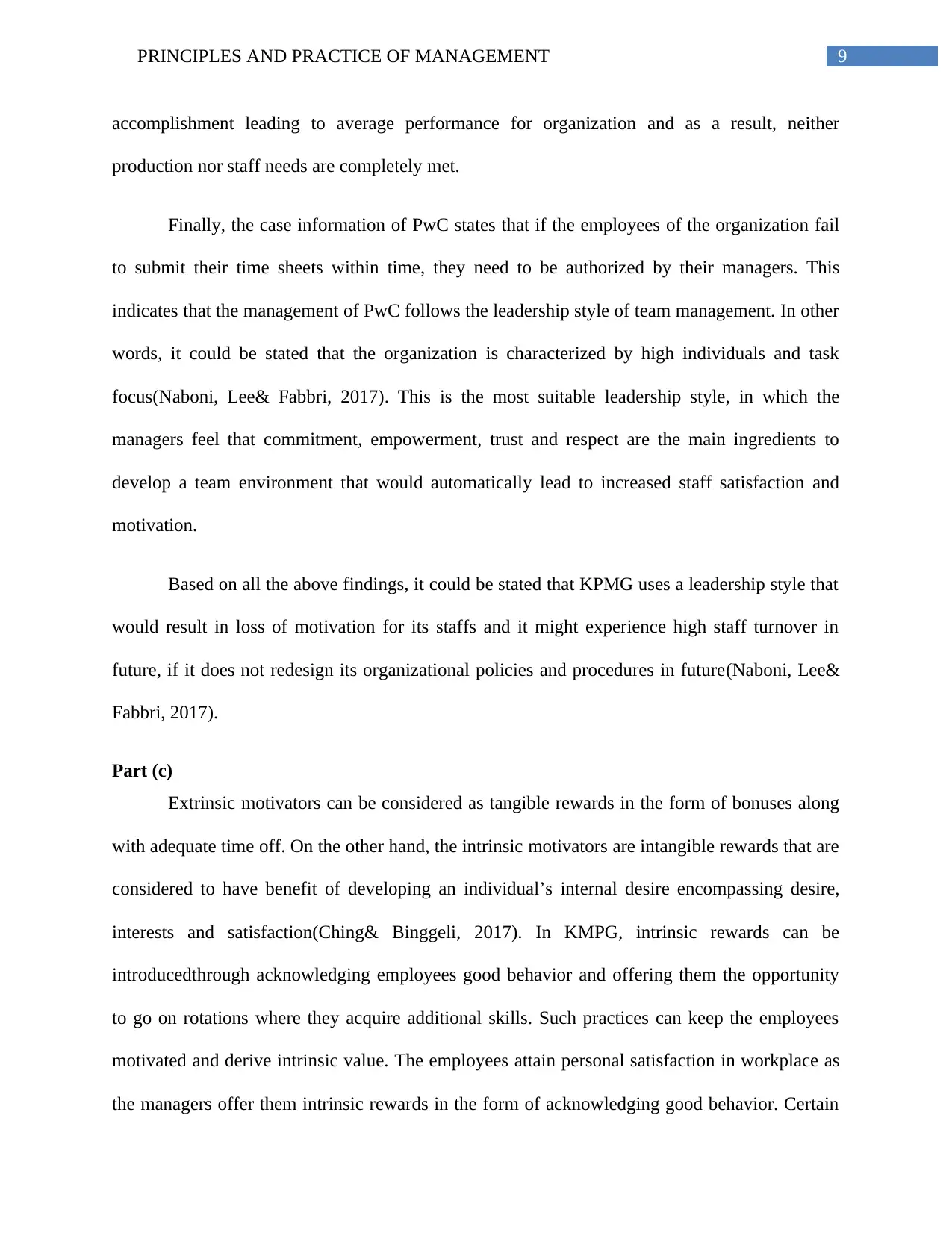
9PRINCIPLES AND PRACTICE OF MANAGEMENT
accomplishment leading to average performance for organization and as a result, neither
production nor staff needs are completely met.
Finally, the case information of PwC states that if the employees of the organization fail
to submit their time sheets within time, they need to be authorized by their managers. This
indicates that the management of PwC follows the leadership style of team management. In other
words, it could be stated that the organization is characterized by high individuals and task
focus(Naboni, Lee& Fabbri, 2017). This is the most suitable leadership style, in which the
managers feel that commitment, empowerment, trust and respect are the main ingredients to
develop a team environment that would automatically lead to increased staff satisfaction and
motivation.
Based on all the above findings, it could be stated that KPMG uses a leadership style that
would result in loss of motivation for its staffs and it might experience high staff turnover in
future, if it does not redesign its organizational policies and procedures in future(Naboni, Lee&
Fabbri, 2017).
Part (c)
Extrinsic motivators can be considered as tangible rewards in the form of bonuses along
with adequate time off. On the other hand, the intrinsic motivators are intangible rewards that are
considered to have benefit of developing an individual’s internal desire encompassing desire,
interests and satisfaction(Ching& Binggeli, 2017). In KMPG, intrinsic rewards can be
introducedthrough acknowledging employees good behavior and offering them the opportunity
to go on rotations where they acquire additional skills. Such practices can keep the employees
motivated and derive intrinsic value. The employees attain personal satisfaction in workplace as
the managers offer them intrinsic rewards in the form of acknowledging good behavior. Certain
accomplishment leading to average performance for organization and as a result, neither
production nor staff needs are completely met.
Finally, the case information of PwC states that if the employees of the organization fail
to submit their time sheets within time, they need to be authorized by their managers. This
indicates that the management of PwC follows the leadership style of team management. In other
words, it could be stated that the organization is characterized by high individuals and task
focus(Naboni, Lee& Fabbri, 2017). This is the most suitable leadership style, in which the
managers feel that commitment, empowerment, trust and respect are the main ingredients to
develop a team environment that would automatically lead to increased staff satisfaction and
motivation.
Based on all the above findings, it could be stated that KPMG uses a leadership style that
would result in loss of motivation for its staffs and it might experience high staff turnover in
future, if it does not redesign its organizational policies and procedures in future(Naboni, Lee&
Fabbri, 2017).
Part (c)
Extrinsic motivators can be considered as tangible rewards in the form of bonuses along
with adequate time off. On the other hand, the intrinsic motivators are intangible rewards that are
considered to have benefit of developing an individual’s internal desire encompassing desire,
interests and satisfaction(Ching& Binggeli, 2017). In KMPG, intrinsic rewards can be
introducedthrough acknowledging employees good behavior and offering them the opportunity
to go on rotations where they acquire additional skills. Such practices can keep the employees
motivated and derive intrinsic value. The employees attain personal satisfaction in workplace as
the managers offer them intrinsic rewards in the form of acknowledging good behavior. Certain
Paraphrase This Document
Need a fresh take? Get an instant paraphrase of this document with our AI Paraphraser

10PRINCIPLES AND PRACTICE OF MANAGEMENT
other intrinsic rewards that if existent in KMPG can motivate them in performing any
challenging job(Ching& Binggeli, 2017). Certain instances of intrinsic rewards that can be
employed by KMPG in driving employee engagement includes recognizing their performance
based on their sense of meaningfulness, choice, competence and progress.
Extrinsic rewards in KMPG can consider giving out bonuses that can generate inequity
for employees those feel under rewarded. These extrinsic rewards that can motivate the
employees can include pay raises, benefits and bonuses(Ching& Binggeli, 2017). For instance, if
the company desires to increase attendancelevels of employees it might consider introducing a
cash reward for the employees that has attained highest attendance all through the year.
Moreover, the company can also offer extrinsic rewards in the form of gifts like gift cards that
can specifically be used for luxuryand personal purposes by employees and can also reinforce the
employer-employee bond(Ching& Binggeli, 2017). Salary raise can also be a form of
extrinsicreward that can motivate employees in indicating impressive performance or new skills.
Similar to employee bonuses, salary increase can be given out to employees after a specific set
time period or for their exceptional performance.
Conclusion
The report revealed that KPMG has imposed fine of £100 on its employees, if they fail to
finish their paperwork within the stipulated timeframe. Moreover, it has been found that KPMG
uses a leadership style that would result in loss of motivation for its staffs and it might
experience high staff turnover in future, if it does not redesign its organizational policies and
procedures in future. Finally, it has been evaluated that rewards in KMPG can consider giving
other intrinsic rewards that if existent in KMPG can motivate them in performing any
challenging job(Ching& Binggeli, 2017). Certain instances of intrinsic rewards that can be
employed by KMPG in driving employee engagement includes recognizing their performance
based on their sense of meaningfulness, choice, competence and progress.
Extrinsic rewards in KMPG can consider giving out bonuses that can generate inequity
for employees those feel under rewarded. These extrinsic rewards that can motivate the
employees can include pay raises, benefits and bonuses(Ching& Binggeli, 2017). For instance, if
the company desires to increase attendancelevels of employees it might consider introducing a
cash reward for the employees that has attained highest attendance all through the year.
Moreover, the company can also offer extrinsic rewards in the form of gifts like gift cards that
can specifically be used for luxuryand personal purposes by employees and can also reinforce the
employer-employee bond(Ching& Binggeli, 2017). Salary raise can also be a form of
extrinsicreward that can motivate employees in indicating impressive performance or new skills.
Similar to employee bonuses, salary increase can be given out to employees after a specific set
time period or for their exceptional performance.
Conclusion
The report revealed that KPMG has imposed fine of £100 on its employees, if they fail to
finish their paperwork within the stipulated timeframe. Moreover, it has been found that KPMG
uses a leadership style that would result in loss of motivation for its staffs and it might
experience high staff turnover in future, if it does not redesign its organizational policies and
procedures in future. Finally, it has been evaluated that rewards in KMPG can consider giving
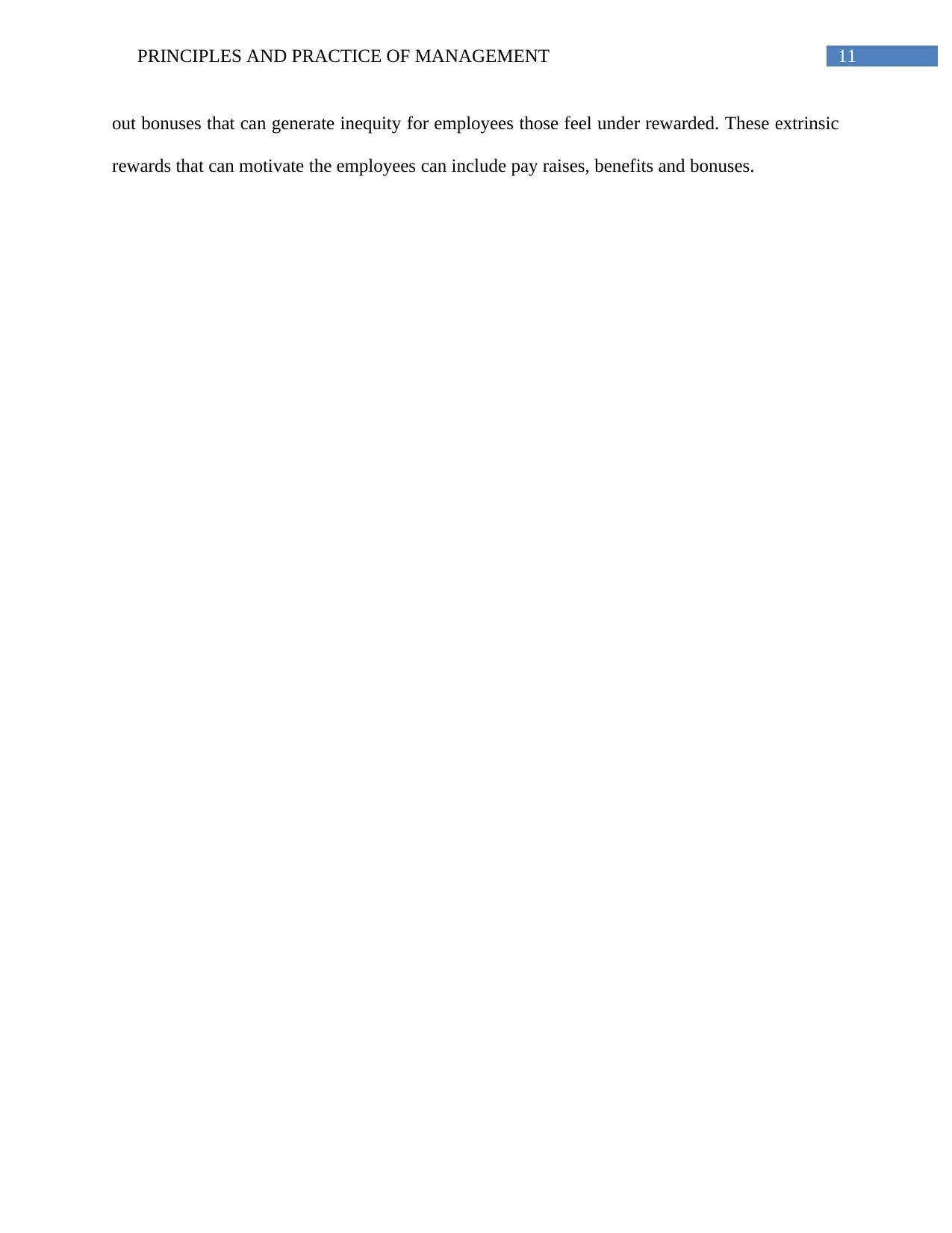
11PRINCIPLES AND PRACTICE OF MANAGEMENT
out bonuses that can generate inequity for employees those feel under rewarded. These extrinsic
rewards that can motivate the employees can include pay raises, benefits and bonuses.
out bonuses that can generate inequity for employees those feel under rewarded. These extrinsic
rewards that can motivate the employees can include pay raises, benefits and bonuses.
⊘ This is a preview!⊘
Do you want full access?
Subscribe today to unlock all pages.

Trusted by 1+ million students worldwide
1 out of 14
Related Documents
Your All-in-One AI-Powered Toolkit for Academic Success.
+13062052269
info@desklib.com
Available 24*7 on WhatsApp / Email
![[object Object]](/_next/static/media/star-bottom.7253800d.svg)
Unlock your academic potential
Copyright © 2020–2025 A2Z Services. All Rights Reserved. Developed and managed by ZUCOL.




